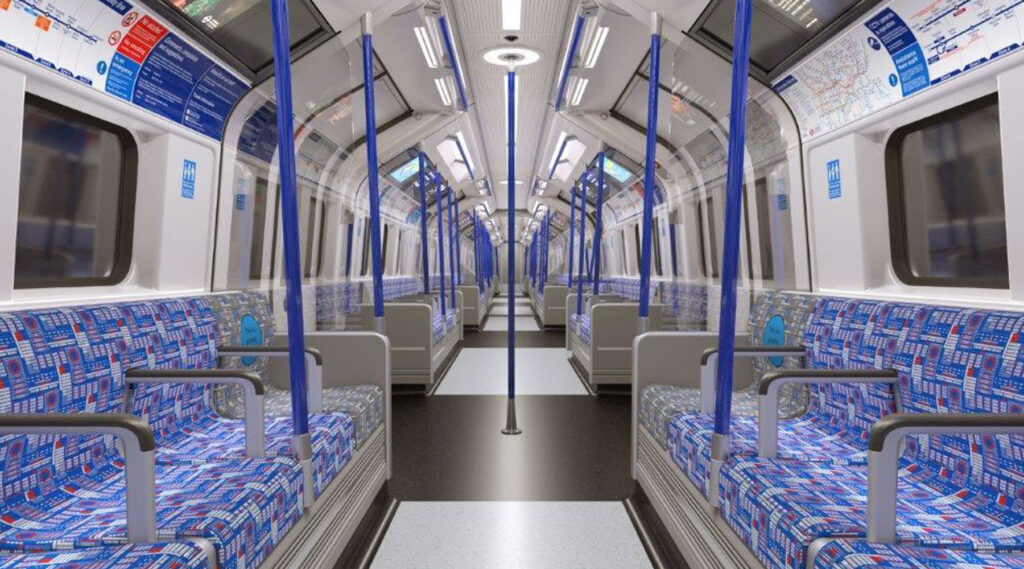TfL has shown off the latest designs for its new fleet of Piccadilly line trains, including the new moquette that will adorn the seats.
The design for the moquette was approved internally by TfL in April following work with the Independent Disability Advisory Group (IDAG) to ensure the trains are fully accessible by improving the colour contrast with the internal grab poles.
At the same time, the cost of buying the fleet of 94 new trains and associated network upgrades has been reduced by around 10 per cent, from £3.29 billion to £2.99 billion. However, the arrival of the first train in passenger service has been pushed back from Autumn 2024 to sometime in 2025.
The delay is mainly due to upgrades on the London Underground network being pushed back, as Siemens, who are building the trains are largely on schedule.
The new fleet of trains is needed as the current trains are over 45 years old, and as the line carries around 10 per cent of London Underground traffic, delaying the replacement of the old trains is not a viable option.
Back in May 2018, TfL authorised the purchase of the new fleet of trains, and the necessary upgrades to the London Underground network to house them, mainly depot upgrades and a lot of signalling work.
The trains represent about half the cost of the contract, with the other half being the upgrades to the London Underground network.
As the trains have much wider doors than the current trains, they can spend less time in stations picking up and dropping off passengers, TfL expects that to enable them to be able to increase peak capability on the Piccadilly line from 24 to 27 trains per hour from 2027.
Along with the 10 per cent additional space inside the trains, the net effect is a capacity increase of around a quarter on the Piccadilly line compared to today.
There is also a — currently on hold — plan to upgrade the signalling system on the Piccadilly line, which would increase capacity from 27 to 36 trains per hour.
The final design has been signed off, and Siemens expect to start manufacturing the first trains this autumn at its factory in Vienna. Production will shift in 2023 to their new factory in Goole, East Yorkshire. In total, around half of the new Piccadilly line trains will be manufactured in the UK.









I hope they have air conditioning.
They do.
They do. I would like to see full ATO.
I appreciate and respect the need for accessibility, but the revised version looks so uninspired and clinical. I had hoped we’d see something a little more refined than the corporate wash of blue, white and grey plastic.
Also what happened to standardising the moquette? I thought that was the whole point of Barman…
I am sure Geoff and Vicki will have a view on this…
When are they going to renew the central line the busiest the warmest the filthiest ?
When they have the money to buy more of these new trains. Will be some years yet.
I think Bakerloo will be last, perversely those trains are so simple and robust they can be refurbished indefinitely (existing motors given new bearings and rewound, control gear rewired etc..a working heritage line, if you like). Maintaining key repair skills is the limiting factor
The original concept in the Siemens renders was far nicer (in my opinion) and could easily have been DDA’d by lightening the grab poles.
It does not matter how “pretty” these new trains are, if the moquette is the wrapping of concrete seats. Or would seat padding add a Billion to the bill……
The London tube is often just a load of old panty. There’s always the promise of something more and better around the corner!
I think the new interior looks cool, as the Piccadilly line blue theme fits these trains very well. They are effectively a miniature version of the current Walk through Thameslink trains also from Siemens too.
Do the IDAG have no issues with the colour contrast of the ‘new’ routemaster which have similar identical grab pole colours?
Why not ask them?
I don’t like the idea of the seats facing each other having just coming out of a pandemic
Amy space for AC?
I wish we had seating in the same layout as the 72 and the S8 stock as they are more communal and they have character like that
I do accept the space requirements
Are these Walk through carriages? Doesn’t look like it on the picture.
Why the seats aren’t made in plastic? at least they can be easily washed and disinfected. And they would be long lasting without the ugliness of faded colour and stains, typical of fabric seats. Moreover, they could save on the and the cost involved in fabricating and replacing the moquette. People vomit (and else) on them: can we truly trust LU on their cleaning standards??? (see Central Line)
I was thinking the same. No other world metro I’ve seen has cloth seats, even pre-pandemic. And also worth noting the wider doors means I assume fewer, narrower seats, just like the Northern and all other lines.